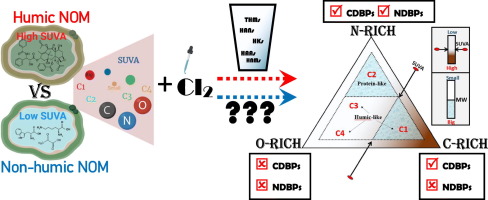Science of the Total Environment ( IF 8.2 ) Pub Date : 2020-04-15 , DOI: 10.1016/j.scitotenv.2020.138638 Lap-Cuong Hua , Shu-Ju Chao , Kochin Huang , Chihpin Huang

|
Disinfection by-products (DBPs) formed upon water treatment is an emerging issue worldwide. While monitoring of DBP precursors can easily be achieved for high specific UV absorbance (SUVA) organic (>6 L/mg·m), low and extremely low SUVA precursors (<2 L/mg·m) are difficult to monitor or even to predict their DBP formation behaviour. This study investigated the relationships among NOM characteristics, such as molecular weight (MW), fluorescence, and chemical composition, with DBP formation resulting from the chlorination of relatively high and low SUVA precursors. High SUVA precursors were formed by C-rich substances (82–85% of total mass) corresponding with high C/N and C/O (>100 and >5, respectively). Such precursors exhibited the fluorescence of long-wavelength humic-like signal and occurred at a high MW range (>30 kDa). By contrast, low SUVA precursors were either N-rich and/or O-rich substances, associated with much lower carbon content (40–70%). Low SUVA, N-rich precursors particularly also occurred at a high MW region (>100 kDa) and produced a strong protein-like fluorescence signal. When SUVA values of O-rich precursors were extremely low (<1 L/mg·m) they were accompanyied by short-wavelength humic-like fluorescence. During DBP tests, high SUVA produced only high yields of carbonaceous DBPs (e.g trichloromethane, haloacetic acids, haloketones), whereas low SUVA N-rich precursors yielded high levels of both C and NDBPs (e.g. haloacetonenitrile, chloropicrin). By contrast, extremely low SUVA precursors produced significantly low levels of both C and NDBPs (total < 30 μg/mgC). Furthermore, 19 of 20 regression models of DBP formation using log-transformed MW gave R2 = 0.50–0.97. The strong regressions and correlations of NOM characteristics with DBPs in this study provide a better understanding of the influence of precursors characteristics on DBP monitoring, especially for low SUVA NOM.
中文翻译:

低和高SUVA前体的特征:分子量,荧光和化学组成与DBP形成之间的关系。
在水处理过程中形成的消毒副产物(DBP)是世界范围内一个新兴的问题。虽然可以很容易地实现对DBP前体的监测以获得高比紫外线(SUVA)有机物(> 6 L / mg·m),但难以监测甚至根本无法监测低和极低的SUVA前体(<2 L / mg·m)。预测他们的DBP形成行为。这项研究调查了NOM特性(例如分子量(MW),荧光和化学组成)与DBP形成之间的关系,DBP的形成是由相对较高和较低SUVA前体的氯化作用引起的。高SUVA前体是由富含C的物质(占总质量的82-85%)形成的,对应于高C / N和C / O(分别> 100和> 5)。此类前体表现出长波长腐殖质样信号的荧光,并发生在高MW范围(> 30 kDa)下。相比之下,低SUVA前体是富含N和/或富含O的物质,且碳含量低得多(40-70%)。低SUVA,富含N的前体尤其也出现在高MW区域(> 100 kDa),并产生强的蛋白质样荧光信号。当富含O的前体的SUVA值极低(<1 L / mg·m)时,它们会伴随着短波长的腐殖质样荧光。在DBP测试期间,高SUVA仅产生高产率的碳质DBP(例如三氯甲烷,卤代乙酸,卤代酮),而低SUVA富含N的前体则产生高含量的C和NDBP(例如卤代乙腈,氯吡啶)。相比之下,极低的SUVA前体产生的C和NDBP含量都非常低(总量<30μg/ mgC)。此外,2 = 0.50–0.97。本研究中NOM特征与DBP的强回归和相关性提供了对前体特征对DBP监测的影响的更好理解,尤其是对于低SUVA NOM。


















































 京公网安备 11010802027423号
京公网安备 11010802027423号